« Good, But Not Good Enough
Is a Low Post Defender Really Needed? »
Season in Review: Tyreke Evans
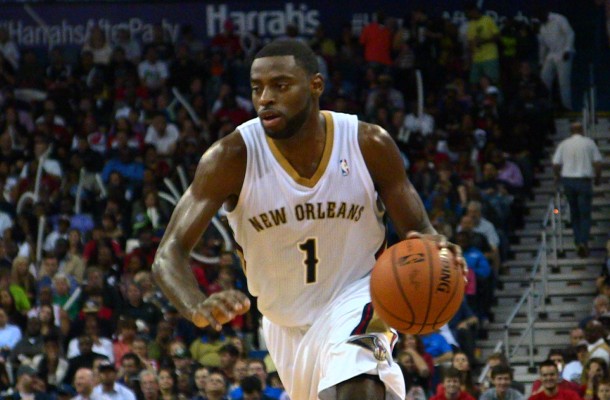
Welcome to our annual “Season in Review” series! Over the next five weeks, the Bourbon Street Shots team will be reflecting back on the performance of every New Orleans Pelicans player throughout the 2013-14 NBA season. Make sure to keep up with the series here, as there is lots of GREAT stuff to come.
On July 5th, 2013, the New Orleans Pelicans acquired guard Tyreke Evans from the Sacramento Kings in exchange for Greivis Vasquez, also sending Robin Lopez to the Portland Trailblazers to make room for Evans’ brand new 4 year, $44 million contract. The move was the second big trade executed by GM Dell Demps, agreed to just over a week after the Pelicans’ draft day trade for Jrue Holiday. In conjunction, the moves signaled a clear change of direction for this New Orleans franchise, quickly shifting away from the “patient rebuild” model to one of a relatively unique nature. Demps and his staff moved to piece together a team of “young veterans” – players who were young and talented, but were not new to the league. More importantly, Dell wanted players who could grow together as a core while still maintaining the ability to move a piece didn’t end up fitting for someone who would.
For the first month or two of the 2013-14 NBA season, Tyreke Evans struggled with inconsistency, seemingly unable to get into any sort of rhythm. As a result, speculation was rampant in regards to whether or not the contract was a good idea. At season’s end, there are still some around the league who question the signing, but those who have watched Tyreke closely are much less skeptical. Without further adieu, let’s dive into the good and bad associated with Evans’ play this season.
Where He Started
The Pelicans dealt for Evans following a peculiar first four years in the NBA with the Kings. After winning the 2009-10 Rookie of the Year Award with averages of 19.5 points, 5.1 rebounds, and 5.6 assists per 36 minutes, he regressed considerably in his sophomore season. From that point, he gradually improved in the subsequent two seasons, achieving his highest true shooting percentage of his career during his last season in Sacramento (though inflated by an unusually high 3-point percentage). When looking at Tyreke Evans’ four seasons there, one thing that stands out is his overall performance based on where he takes his shots (courtesy of basketball-reference.com):
If you order Evans’ first four seasons from best to worst based on PER, you’ll also end up ordering them based on the percentage of shots he attempts at the rim. Though not a big surprise given his skill set, it paints a pretty accurate picture in regards to what Evans needs to do in this league to be most successful (keep this in mind for later). On that note, let’s take a look at some of the numbers Tyreke put up this season.
2013-14 Advanced Stats
When presenting Evans’ statistical output, it simply cannot be done without showing his production both from a starting and bench role (all data from the NBA’s media stats tool except for PER, which came from ESPN). Early on in Tyreke’s first season in New Orleans, he often struggled to get into any sort of rhythm, and the numbers back up that assessment. He was below average for his position in most statistical categories apart from rebounding (his rebounding will come up again later). However, after entering the starting lineup – largely out of necessity due to injuries – Evans began to flourish. Despite seeing more minutes against the opposition’s best talent while playing alongside the same level of talent as before or worse (again, thanks to injuries), his eFG and TS% shot up about 10% each, and experienced no significant drop-off in any other category. On a per-36 minute basis, he went from scoring 17.4 points on 16.2 shots (1.07 PPP) all the way up to 20.3 points on 15.5 shots (1.31 PPP).
2013-14 Season Strengths
Shot Selection
Tyreke Evans’ poor shooting has been a hot topic around the league this year, from NBA bloggers all the way to Grantland. It is true, Evans has been a very bad shooter this season; however, unlike many who refuse to admit it (hi, Josh Smith!), he knows that it is true. Here is a shot chart that you won’t often see, and it is arguably more telling than his overall shooting percentage:
That’s right, folks; 75.7 PERCENT of Tyreke’s field goal attempts this season came within five feet from the rim. Fast forward to only the games that Evans started, and that number increases even further to around 78%. Even more impressive is the fact that, despite A) opponents knowing how much Tyreke struggles with his jumper and B) how often he played alongside teammates with similar shooting deficiencies, he was still able to get to the rim so frequently. His knack for getting into the paint while still maintaining the discipline to stick with what he is good at is a rare combination in this league, and one that he should be able to build on with a healthy Pelicans lineup creating more space for him to operate.
Rebounding
Though an area of his game that was not often discussed this season, Tyreke Evans’ rebounding is not something that can be overlooked. Evans posted career highs in both offensive and defensive rebound rates with the Pelicans, using his superior athleticism to get around bigger players to collect misses.
Per HoopData, the historical averages for rebound rates among guards (Evans’ main role once entering the starting lineup) are about 2.5% for ORR, 10% for DRR, and 6.3% for TRR; Evans finished well above each of those numbers as a starter with a 4.8% ORR, 13.0% DRR, and 8.9% TRR. Even if you switch from guards to swingmen (the role that Evans started the season filling off the bench), the typical league averages only increase to about 4%, 12%, and 8% respectively; Tyreke matched this offensive rebound rate off the bench, but far surpassed that defensive rebound rate at 16.7%.
Though the Ryan Anderson & Anthony Davis front court pairing provides major offensive upside, one of its weaknesses is defensive rebounding. In future lineups in which Evans plays alongside the floor spacing that those two provide, his effort on the defensive glass will be even more important.
Offensive Decision-Making
Tyreke Evans entered the NBA as a score-first point guard, often struggling to get his teammates going. In his first season with New Orleans, Evans appeared uncomfortable in his role off the bench, eventually finding his groove in the starting lineup. Yes, the ease with which he gets to the rim is his best NBA skill, but what many have overlooked is his decision-making ability with the ball in his hands. Per the NBA’s player tracking data, Evans ranked 3rd in the NBA in drives per game with 10.1, and the Pelicans scored 1.17 points per possession on those drives, an efficient source of offense even though his conversion rate on those drives was only 45.1%.
What may be an even more impressive finding from that player tracking data, though, is his success rate when he passes. Among the top 50 NBA players in assists per game (Tyreke is 40th), he ranks 4th in the percentage of his passes that result in assists (total assists / total passes) at 14.9%, behind only Stephen Curry, Ty Lawson, and Chris Paul. Even when Evans fails to convert inside, he realizes that this choice often provides his team with the greatest chance to score, whether it is him or a teammate like Anthony Davis on the offensive glass. If he sees someone else while attacking who has a better chance to score, he’ll dish it off to that player.
“East-to-West” Defense
Though not typically respected for his defense, Tyreke Evans showed excellent lateral mobility on defense this season, despite other more team-focused measures that may indicate otherwise. Given all of the Pelicans’ injuries this season, using individual numbers may paint a better picture with a one-season sample size. Per SynergySports, Evans was an above average defender in both isolation and P&R ball-handler situations, as well as one of the best in the league in handoff plays. Things get a bit more dicey when he is matched up against shooters, but when Evans is one-on-one with the task of preventing his man from getting to the rim, he often succeeds.
2013-14 Season Weaknesses
Perimeter Shooting
I’m just going to leave this here…
So, yeah, needless to say… no bueno. Though Evans has demonstrated the ability to get to the rim with such frequency despite his poor shooting, it would certainly help his cause if he could improve his jumpshot and force defenders to respect him from distance. Given his consistency from the free throw line – he has converted between 77% and 78% of his free throws for the past four seasons now – it stands to reason that Evans could develop a more respectable jumper. Unfortunately, that shot has never presented itself on a consistent basis. If Tyreke could become even an average jump shooter, it would do wonders for both his room to operate individually as well as overall floor spacing for his team. Fortunately, Evans is so talented that he is a very effective player even without this weapon in his arsenal, but there is no question that improving this area of his game would be incredibly beneficial.
Finishing at the Rim
As presented in the shot chart above, there is no question that Tyreke Evans converted at the rim at a below-average rate. While his below-average conversion rate from the restricted area is frustrating, this shortcoming certainly cannot be attributed just to him; playing alongside Greg Stiemsma and Al-Farouq Aminu doesn’t exactly encourage defenders to leave the paint. In fact, take a look at the Pelicans’ worst 3-man lineup with at least 100 minutes played together (via NBA.com’s media stats tool):
The Pelicans got outscored by 33.4 POINTS per 100 possessions with those three players on the court together; for what it’s worth, that lineup was also the worst 3-man lineup in the ENTIRE NBA with at least 150 minutes played this season. Conversely, take a look at the Pelicans’ top 10 most effective two-man pairings with at least 200 minutes played together:
Tyreke Evans shows up twice. With who? Luke Babbitt and Ryan Anderson, far and away the best two perimeter shooting big men on the team. Despite the fact that both players are below average defensively (that is putting it lightly in Babbitt’s case), the Pelicans outscored opponents by a sizable margin when Evans played with stretch 4s. The data is there: front court players who can stretch the defense away from the paint give Evans more room to attack, and as a result, the team operates far more efficiently. Ultimately, a combination of Evans improving his jumper and playing with more shooters should make Evans a devastating threat with the ball in his hands, but even one of those two changes would make a big difference.
“North-to-South” Defense
Though Tyreke typically stayed in front of his man, he didn’t always stay close enough to him. Evans defended spot-up shooters more than any other type of offensive possession and rated below average in this regard, allowing a point per possession. In his defense, these looks were sometimes a result of an effective screen, and giving up a jumper is typically better than allowing a shot at the rim. That being said, Evans’ decision-making process in terms of when to sag off of his man has room to improve; he is one of the best athletes in the NBA, and should feel comfortable relying more on his athleticism when defending some of the better shooters in this league.
Summary
In many ways, the 2013-14 season was a learning experience for all those involved with the new-look New Orleans Pelicans. Tyreke Evans is a unique talent, and like many NBA players, his effectiveness depends to a large extent on how he is utilized. Coach Monty Williams has now seen Evans in multiple roles for his team, and there should be little controversy in regards to how he can be most effective. Yes, improving his shooting touch and playing with a higher degree of defensive awareness will make him an even greater asset to this Pelicans team, but potentially even more important is deploying Evans in the right role with the right teammates. Surrounding Tyreke with shooters, especially in the front court, will allow him to utilize his biggest strength more effectively. Playing him alongside Jrue Holiday, another play-making guard with even stronger passing skills, will give opposing defenses headaches trying to stop two ball handlers who create so well for themselves and others. With a fully healthy New Orleans roster next season (knock on all the wood you can possibly find), Tyreke Evans will be playing with more talent than ever, and as a result, there is good reason to expect him to have his best NBA season to date.
Check out the entire Season in Review series here at Bourbon Street Shots.

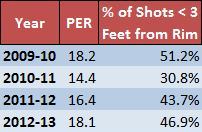

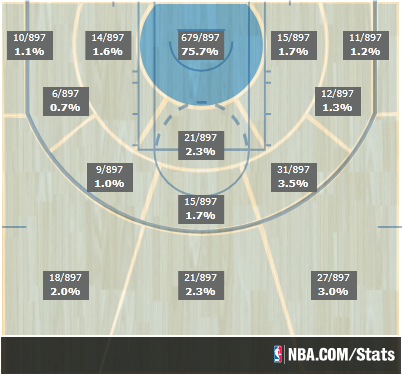
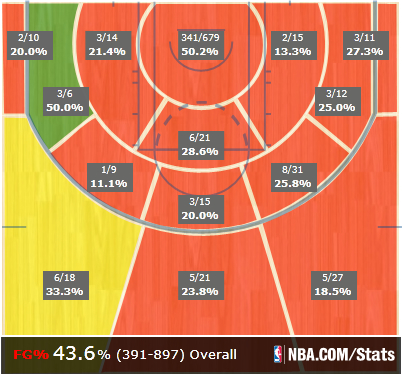
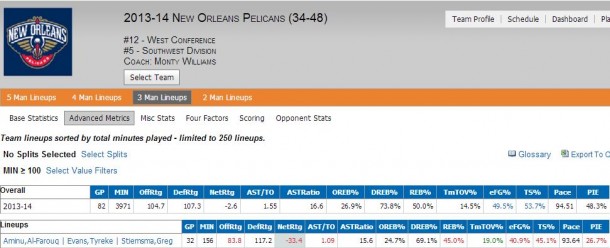
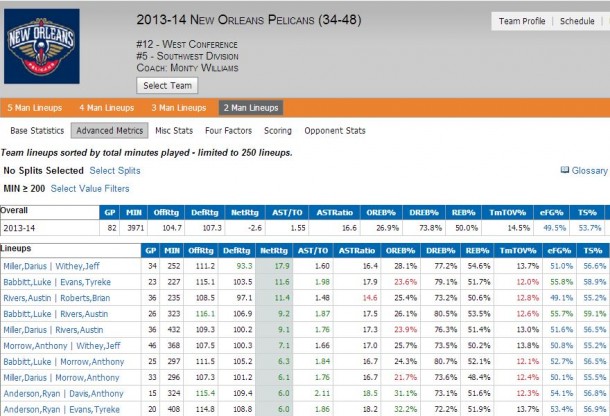




Pingback: Today We Remember the New Orleans Pelicans - Hardwood Paroxysm - Unbiased opinions from extremely biased people.